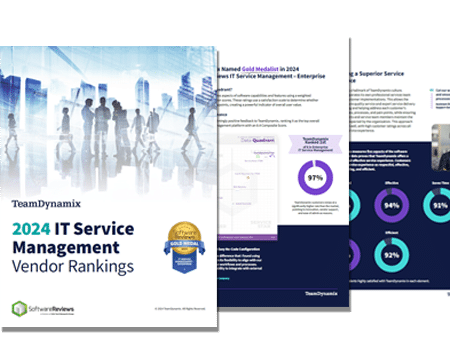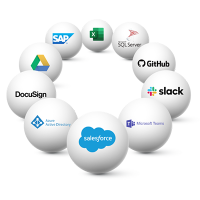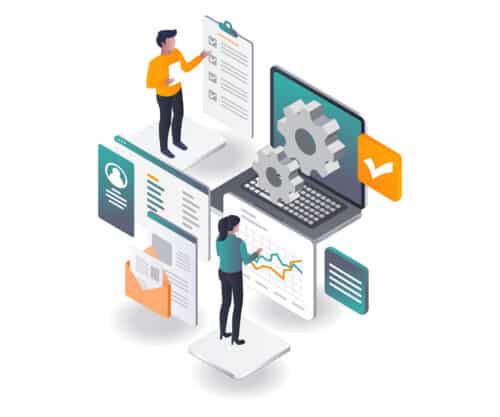
Enterprise Service Management: Why a Unified Platform Matters
Enterprise Service Management (ESM) is the practice of extending IT Service Management (ITSM) principles beyond the IT department to other areas of an organization. ESM

The Info-Tech ranking report offers a unique view of the market based entirely on in-depth customer interviews. Download the Info-Tech ITSM Quadrant and Customer Viewpoint report today.

We’ll show you some of our best situations and show you exactly how to execute them to get immediate results. The best part is, iPaaS tools often feature easy-to-use click and drag functionality, meaning you don’t need a dedicated employee building integrations and workflows.

System Integrators, Value Added Resellers, Technology Providers, and Buying Consortiums can benefit from a partnership with TeamDynamix.

The Info-Tech ranking report offers a unique view of the market based entirely on in-depth customer interviews. Download the Info-Tech ITSM Quadrant and Customer Viewpoint report to gain a better understanding of key vendor strengths and emerging market requirements.
ITIL change management is fundamental when it comes to having a mature IT organization. ITIL change management improves visibility and brings assets, configuration items, change requests, tickets and projects all together on one configuration management database (CMDB).
And while change management is a critical component of improving an organization’s IT maturity, for change management to work you need to understand the ITIL standards that are the foundation of proper change management.
Within IT departments, most organizations use IT Service Management (ITSM) platforms to effectively manage the change management process, so it’s critical that the ITSM tool you use supports ITIL.
ITIL (Information Technology Infrastructure Library) is a framework often used within ITSM and is made up of a set of specific methods, practices and processes for managing an organization’s IT operations and services.
The ITIL framework bases itself on the five phases of the service life cycle. The guidelines set out the necessary processes, associated challenges and best practices for each phase of the service life cycle, as well as the requirements for the implementation of each phase. These guidelines can, and should, be used to kick off internal discussions and policy creation within an organization to ensure service delivery is optimized appropriately for the end user.
Did you know that, according to studies, 80 percent of all issues reported to IT are actually the result of poor change management? That’s why many companies follow the ITIL approach along with release, asset and project management.
Here are some of the benefits of ITIL change management for IT organizations:
Overall, ITIL change management provides a structured approach to managing changes to IT systems, which can help IT organizations improve service quality, reduce downtime, manage risks, increase efficiency and comply with regulatory requirements.
When evaluating a new ITSM vendor, or your current ITSM tool, it’s important to make sure you can do the following for proper ITIL change and release management:
With ITIL it’s important to consider each of the following when rolling out a new change:
By using the ITIL change management process, you can mitigate the unforeseen consequences and downtime that stem from improper or non-existent planning and controls.
By managing and documenting changes, you can avoid major – often avoidable – issues that might creep up as a result of the change you are making.
One way to build out your change management process is by taking a risk-based approach to change review and approval. This means changes are evaluated in terms of risk. To do this, you need to start by defining your risk levels:
When using multiple levels of risk to determine the path of approvals, it is important to have a clear definition of each level. Factors to consider include:
If you implement an approach like this, consider structuring your deadlines and meetings in such a way that escalating a change to a higher-level review does not take much time.
For example, to efficiently escalate a change from the CAB to the ITMB:
If you need an example of great change management check out what Northeast Ohio Medical University (NEOMED) is doing.
Prior to implementing ITIL change management practices, NEOMED was struggling with unforeseen issues after each technology-related change.
Using TeamDynamix for their ITSM, they were able to build out a comprehensive and well-thought-out change management strategy to address these issues.
“We set up a special form within the system called a change form, and whenever a production change is pending, we have the technical lead fill out that form,” Geri Hein, project manager within the university’s IT division, said. For larger changes, the change form is routed to a change control team that consists of Hein, a business analyst, the managers of the university’s IT infrastructure and database groups, and the IT director.
This process has increased communication within the IT division and helped with troubleshooting problems.
Now, whenever a change is coming, the key people who need to be aware are automatically notified in advance, so they can weigh in if they foresee any risks or dependencies in order to ensure a smooth transition. Changes are linked automatically to the ticket calendar feature within TeamDynamix, so IT staff can easily see which changes were made on which days.
“If there’s a problem, we can go to the calendar and determine whether it was related to a particular change or not,” Hein says. “There have been a few instances where our infrastructure team made changes that we didn’t think would cause problems with our ERP system, but they did. [Because of the change management process] we were able to track it back to the right source and easily resolve the issue.”
At Legacy Supply Chain Services, they made the switch to TeamDynamix after going to market for a change management solution.
“We started our search with Info-Tech looking at just change management tool to add to our existing ITSM tool at the time, then realized we also wanted to find a tool that could help us automate processes,” he said. “Info-Tech provided us with some great options, so we started the vetting process and found that TeamDynamix really fit our needs – not just for change management and automation, but for everything.”
“We were blown away by all that TeamDynamix offers, and our renewal was up with our former ITSM tool so we decided to just replace it all,” Keyon Farrier, service desk manager at Legacy Supply Chain Services, said. “We were really excited about the out-of-the-box features from TeamDynamix and knew the tool would help not just with change management and automation, but with some of the other challenges we were facing as well.”
As a result of the switch to TeamDynamix “we’ve become a lot more efficient as a team because we’re getting the right tickets to the right people faster,” said Farrier. “We can now respond to service requests quicker as well. And we have a lot more visibility in terms of reporting.”
With TeamDynamix, the Legacy Supply Chain Services implemented a self-service portal—and IT staff have taken the time to build out forms that gather as much information on the front end as they can. As a result, “We’re now able to provide support in a timelier fashion,” he said.
What’s more, by expanding the number of service categories they have, Legacy’s IT team has been able to create more accurate reporting.
“Having better reporting has allowed us to focus our attention on areas that are demanding change,” Farrier said. “We can engage the right individuals to bring forth the right type of change based on the data we’re seeing.”
With more accurate information, Farrier and his team can address the root cause of problems, instead of repeatedly addressing the same types of service issues. “This has been a tremendous help to our overall processes and reducing the drain on our IT resources,” he concluded.
Click here to learn more about change management and TeamDynamix IT Service Management.
This article was originally posted in May 2021 and has been updated with new information.

Enterprise Service Management (ESM) is the practice of extending IT Service Management (ITSM) principles beyond the IT department to other areas of an organization. ESM

As businesses grow, so does the complexity of managing their services. This is where Enterprise Service Management (ESM) comes in, offering a structured approach to

As IT departments modernize their service management tech stacks, automation stands out as a pivotal force driving significant transformations in how the IT service desk
TeamDynamix’s award-winning SaaS cloud solution offers IT Service and Project Management together on one platform with enterprise integration and automation.
[email protected]
(877) 752-6196
Contact Us
